Odin class Submersibles (1928)
 Oceanic Submersibles 1924-1945:
Oceanic Submersibles 1924-1945:
HMS Oberon (prototype), HMS Oxley & Otway (Australian order), HMS Odin, Olympus, Orpheus, Osiris, Oswald, Otus
[wpcode id="40029"]
HMS Oberon
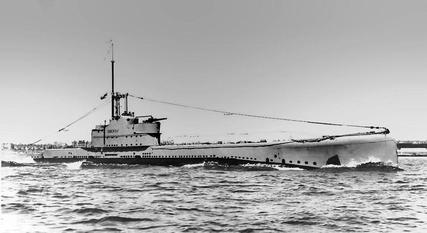
HMS Oberon was the Odin-class prototype, more than the Oxley class, a derivative planned for the Royal Austrlian Navy. Originally called "O1" she received a full name, HMS Oberon, after a Shakespearian nickname meaning "noble, bearlike" (the very first to be so named, and 5th RN vessel of that name). Commissioned as part of the
1923 naval programme, she was built after the Anglo-Japanese Alliance expired in 1922, with the admiralty willing to create a fleet of far east oceanic submarines able to of long-range patrols there, and possibly deter Japanese ambitions.
Design of HMS Oberon
HMS Oberon had nothing to do with the previous X1 cruiser submarine. She was not tailored to engage an escort and deal with the convoy's ships, but of a more conventional design, with engineers starting with L-class submarines instead of a blank page. The design was thoroughly modified on several points: 9.8 m longer, 0.91 m wider, slower by two knots but with almost twice the range, and also twice as many torpedo tubes and torpedoes in reserve.
HMS Oberon had a crew of 54, while being 82m long overall, 8.5m wide, 4.7m in draft when surfaced. Displacement reached 1,332 t surfaced, 1,860 t underwater. This time, the admiralty discarded the idea of "borrowing" German machinery and instead adopted two Admiralty diesel engines, rated at 2,950 hp (2,200 kW), and two electric motors rated at 1,350 hp (1,010 kW). They were mated on a propeller shaft each. Top surfaced speed was not stellar at 13.75 knots (25.47 km/h) -although still enough to catch most merchant ships- and down to 7.5 knots (13.9 km/h) underwater. These figures were obtained on trials, but the blank specs back when ordered specified 15 knots (28 km/h) and 9 knots respectively...
Her pressure hull was made of a 19 mm steel thick plating on which both ballast tanks were mounted. This scheme allowed a max depth of 150 m, but it remained theoretical. While in service she never went below 61 m. She carried no less than 189 t of fuel in riveted outer tanks and later welded tanks due to leakages, when refitted in 1937.
Her original armament comprised a single QF 4 inch/40 Mk IV deck gun (Mk XII in 1937) and no less than eight 533 millimeter torpedo tubes, six in the bow, two in the stern. Provision was for sixteen torpedoes in all, of the Mark IV type and from 1938, Mark VIII.
More importantly, she was the first RN submarine fitted with ASDIC while being constructed. She also had type 709 hydrophones plus a SF type direction finder, really useful in the vast expanses of the Pacific. In WW2 she gained a single 20 mm/70 Mk.IV Oerlikon AA gun on her rear conning tower platform, plus a Type 291W direction finder to provide early air warning by default of a radar.
 HMS Oberon in action
HMS Oberon in action
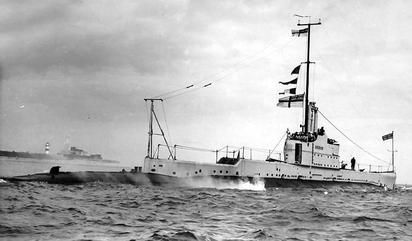
HMS Oberon was completed Chatham Dockyard (Kent) and commissioned on August 24, 1927. Her initial pennant was 21.P, changed to 21.N in 1939, and N.21 in 1940.
Her initial sea trials revealed torsional vibrations in her propulsion machinery. Thus, she was never deployed to the Far East du to the lack of repair facilities there. Instead she was stationed in Portsmouth from 1927 and 1931. She was moved from there to the Mediterranean and back to Portsmouth in 1934. On October 11, 1935, she collided with the destroyer HMS Thanet at Devonport. Placed in reserve in 1937, she returned to fully active service by August 2, 1939. She was not deployed for active missions due to her age and instead, was used for training. She was decommissioned at Blyth on 5 July 1944, sold for scrap on 24 August 1945 and BU by Clayton and Davie (Duntson).
 L23 for comparison (1921)
L23 for comparison (1921)
 HMS Odin
HMS Odin
 HMS Oberon
HMS Oberon
⚙ Oberon specifications |
| Displacement | 1,311 long tons surfaced, 1,892 long tons submerged |
| Dimensions | 270 x 28 ft (82 m x 8.5 m) |
| Propulsion | 2× diesel engines, 4,600 hp (3,400 kW), 2× electric motors, 350 hp (260 kW) |
| Speed | 15.5 knots (17.8 mph; 28.7 km/h) surfaced, 9 knots submerged |
| Range | 8,400 nmi (15,600 km) at 10 kts surfaced, 70 nmi (130 km) at 4 kts submerged |
| Test Depht (tested, not max) | 300 ft (91 m) |
| Armament | 8× 21-in TTs, 16 Torpedoes, QF 4-in (102 mm) Mk XII deck gun, 2× Lewis LMGs AA |
| Crew | 54 officers and ratings |
The "Australians": Oxley and Otway
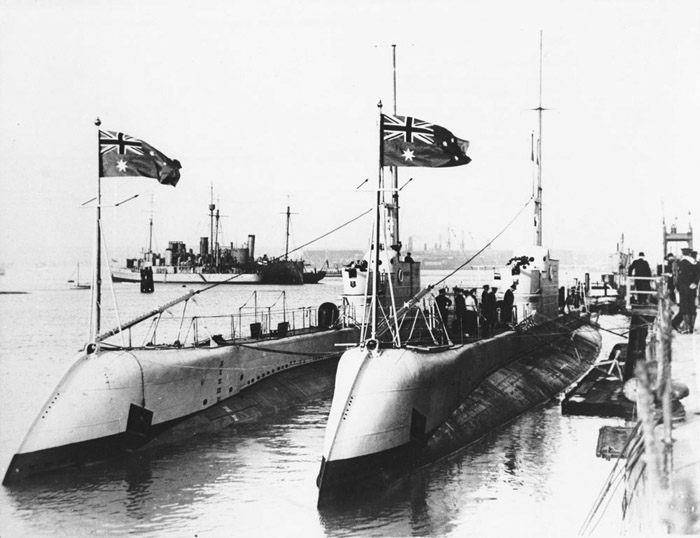
The Oxleys were Odin-class submarines built to a slightly modified design, for Australian service. Indeed, the oceanian continent had a small but potent surface fleet, but lacked submersibles as a deterrence; which became more a concern after the anglo-japanese alliance treaty was ceased. For the same reasons the construction of HMS Oberon and the Odin class was ordered in the first place, to counter a possible expansion of Japan in the far east, the Royal Navy wanted a group of long-range submeribles able to deter the IJN from encroaching on its colonial waters and interests in the region. Australia not only had the manpower, but also the resource and will to integrate submersibles in its fledging navy, and an agreement was struck. After HMS Oberon, the next two submersibles laid down over a slightly revised design would be completed for Australia.
Design of the class
Fact is they were launched sooner and are often seen almost as a preserie for the Odins, which they were'nt. Measuring 275 feet (84 m) overall, by 29 feet 7 inches (9.02 m) in beam and for a mean draught of 13 feet 3 inches (4.04 m) they were slightly smaller than the Odins. Displacement was limited to 1,350 tons (versus 1780 for group II) surfaced, 1,870 tons submerged (1892 tons for group I, 2030 tons for group II). Compared to the Oberon, they had the same basic Vickers design, but with improvements in hull form (after many basin tests), and were able to reach a marginally better speed. Officially it was still 15.5 knots surfaced.
Like HMS Oberon they had a British powerplant, with diesel engines for surface navigation, also procuring electricity via dynamos and batteries which fed her while underwater through a set of two electric motors, mated each on a single propeller shaft.
Maximum speed was 15.5 knots (28.7 km/h; 17.8 mph) surfaced, 9 knots (17 km/h; 10 mph) submerged, as HMS Oberon and the following Odins.
Oxley and Otway had a crew of 54, their armament were a repeat of Oberon, eight 21-inch (530 mm) torpedo tubes, six forward, two aft and a single 4-inch (100 mm) deck gun, plus two machine guns on their aft platform in the large kiosk.
HMS Oxley (named after explorer John Oxley) was laid down at Vickers-Armstrong in its Barrow-in-Furness facility in March 1925 under the initial designation OA1 (Oberon was "O1"). She was launched on 29 June 1926 and completed on 22 July 1927, commissioned into the RAN (
Royal Australian Navy) on 1 April 1927.
Fact is they did not served long for the RAN. In 1931 another deal had them sent back to the Royal Navy between tonnage limits of the London treaty and the unexpected high maintenance cost of the two O class submersibles.
 HMS Oxley in service
HMS Oxley in service
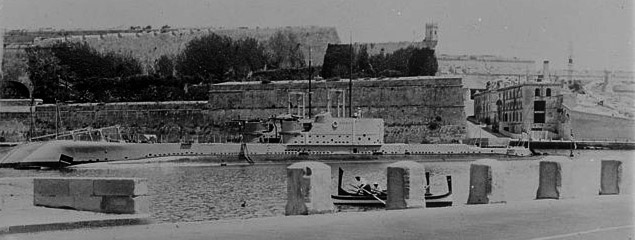
After commission, HMS Oxley and Otway were assigned to the 5th Submarine Flotilla but on 8 February 1928, they were sent to Australia, making the longest unescorted voyage for any British submarine. They had to stop in Malta for patching up cracks in both subs engine columns. New improved columns were fabricated and installed and they departed in November, reaching Sydney on 14 February 1929. However with Great Depression, both were placed into reserve in 1930, but made a few exercizes until April 1931 and eventually both were transferred to the RN, economic reaons compounded by London Naval Treaty tonnage limits for Austrlia. Recommissioned on 10 April 1931 they started their second career.
On 29 April, they departed for Malta and once in the Med, multiplied exercizes. In 1939, they were back home in Portsmouth, 5th Submarine Flotilla, then 2nd Submarine Flotilla and August deployed at Dundee and Blyth. Oxley patrolled off the coast of Norway but on 10 September 1939, she was mistook for a U-Boat and sunk by HMS Triton. First submarine loss and first "blue on blue" incident of that nature. It happened when the five submarines of the Second Flotilla (including Triton and Oxley) patrolled on the "Obrestad line" off Norway.
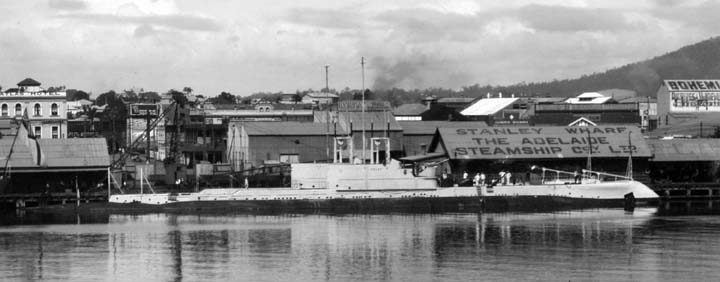
A Board of Enquiry after that event found that Cdr. Steel had done "all he reasonably could" in the circumstances in that HLS Oxley was out of position, although to maintain morale, the loss was attributed to "an accidental explosion", the info made public only in the 1950s.
 HMS Otway in Service
HMS Otway in Service

Otway was laid down in March 1925 as "OA2", launched on 7 September 1926, commissioned into the RAN on 15 June 1927. She had the same fate as her sister, seeing little service in Austrlia before sent back to the RN between tonnage and budgetary reasons. When back home she was given the pennant number 51. She served in the same unit as her sister, the 5th sub flotilla patrolling in 1939 off Norway. In 1942 she fell under command of Captain Howard Bone, seeing service in the same service and eventually becoming a training sub in 1945. She was discarded and by August 1945, sold to Thos. W. Ward, Inverkeithing in Scotland for dismantling.
⚙ Oxley specifications |
| Displacement | 1,350 long tons surfaced, 1,870 long tons submerged |
| Dimensions | 275 ft x 29 ft 7 in x 13 ft 3 in (83.8 x 9.02 x 4.04 m) |
| Propulsion | Same as Oberon |
| Speed | Same as Oberon |
| Range | Same as Oberon |
| Test Depth | Same as Oberon |
| Armament | Same as Oberon |
| Crew | Same as Oberon |
The Odin class
Design
The Odin class was built to replace the WWI vintage
L-class submarines which lacked the radius of action to be fit for the Pacific Ocean. The designers cared much for the hull, strongly built in order to resist much greater pressures and be theoretically able to support a dive down to 500 feet (150 m). The "safe" dive was of 300 feet (91 m) in practice. Armament consisted was classic for a large patrol boat with eight tubes in all, 21-inch (533 mm) with six in the bow and two in the stern plus a 4-inch (102 mm) gun, all shared with Oberon and the two Otway.
They used at the time a saddle tank type which carried fuel in riveted external tanks. The problem was rivering as they were external seemed obvious: Leakages after a depth charge damage. Not only the submarine would bled her oil, this also betrayed her position (see later). However the Odin class were first British submarines fitted with Asdic and a VLF radio usable at periscope depth.
The ability to dive quickly as well as deeper were in consideration and the usual objective looked at was at disappearing at two feet per second. The minimum dive time from full buoyancy to periscope depth was to be around a minute.
With the Odin Class a requirement was added for these to be able dive in fresh water (like in the great lakes and some large rivers like the Yangtse). Engineers thus made changes to the compensating water tanks to cope with the water density differences and variations. This the Odins were the only ones able to dive in a specific gravity from 1.00 to 1.30 and stayed a standard for all British Submarines (and not only). It was later moved from 1.015 to 1.03.
Not only the Odin Class, but also the Parthian and Rainbow Classes were designed to at 500 feet but were only tested at 200 feet (Oberon) up to 300 feet for the other ones. It was said at the time, these were safe depht, but like German U-Boats, they were capble of divng way deeper, beyond 500 feet in case of emergency.
The Director of Tactical Division by 1928 estimated this 500 ft capability worked hand in hand woth the capability of withstanding depth charge blasts. There was also the always possible involuntary deep dive mostly due to an issue with the diving planes (jammed), something which was quite frequent.
Conumption was also an issue: When patrolling, the daily fuel consumption was 2.1 tons. It allowed for 12 hours underwater, 12 hours cruising surfaced at low speed, eight hours charging. On this, HMS Orpheus distingushed hersrlf in the Odin class as the only one fitted with a Vulcan clutch and her consumption rose to was 2.6 tons daily.
⚙ Odin Group I specifications |
| Displacement | 1,311 long tons (1,332 t) surfaced 1,892 long tons (1,922 t) submerged |
| Dimensions | 275 x 28 ft (83.8 m x 8.5 m) |
| Propulsion | 2× diesel engines, 4,600 hp (3,400 kW), 2× electric motors, 350 hp (260 kW) |
| Speed | 15.5 knots (17.8 mph; 28.7 km/h) surfaced, 9 knots submerged |
| Range | 8,400 nmi (15,600 km) at 10 kts surfaced, 70 nmi (130 km) at 4 kts submerged |
| Test Depht (tested, not max) | 300 ft (91 m) |
| Armament | 8× 21-in TTs, 16 Torpedoes, QF 4-in (102 mm) Mk XII deck gun, 2× Lewis LMGs AA |
| Crew | 54 officers and ratings |
⚙ Odin group II specifications |
| Displacement | 1,781 long tons (1,810 t) surfaced 2,030 long tons (2,060 t) submerged |
| Dimensions | 283 x 30 ft (86.4 m x 9.1 m) |
| Propulsion | Same |
| Speed | 17.5 knots (20.1 mph; 32.4 km/h) surfaced, same submerged |
| Range | same |
| Test Depht (tested, not max) | Same |
| Armament | same |
| Crew | same |
The Odin class in action:
 HMS Odin
HMS Odin
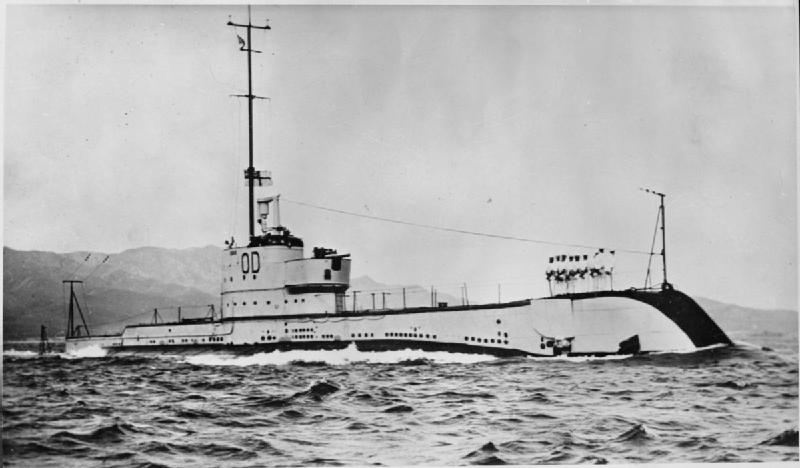 HMS Odin off Hong Kong in 1931
HMS Odin off Hong Kong in 1931
HMS Odin (N84) was built in Chatham, Kent, on 23 June 1927, launched on 5 May 1928 and commissioned on 21 December 1929. The name was originated on a Danish 74-gun, man-of-war captured by the British in 1807 and used again on an early Cold war british submersible design (Oberon class).
HMS Odin served with the 5th Flotilla in Portsmouth in 1929–1930 for her initial training. Next she was sent to her intended posting, travelling through the Mediterranean and Indian Ocean and up to the join the 4th Flotilla based in Hong Kong, where she served from 1930–1939, but apparently also in Singapore with the 8th flotilla.
With the war coming, she was transferred to the 8th Flotilla moved from Singapore to Colombo, Ceylon by October 1939. In mid November 1939 as the Pocket Battleship
Graf Spee rounded the Cape, together with HMS Otus she was dispatched into the Chagos and Maldive Islands when alerted of the German raider's position. She later patrolling with Olympus in March 1940, searched these Islands until reporting the area was afe enough for a troop convoy carrying ANZAC's to sail for the Middle East.
By mid-1940, with the entry of Italy into the war she was reassigned to the 1st Flotilla based in Alexandria, with fover other boats including of her class.
When Italy declared war on 10 June 1940, Odin was patrolling off the Italian Naval Base at Taranto.
Her service was short: During one of her first patrols she was spotted surfaced duiring the night, submerged, was depth charged, damaged and forced to surface again, where she was rammed by the Italian destroyers Strale and Baleno. She sank in the Gulf of Taranto, on 13/14 June 1940. One of the first of numerous British submarine loss in this theater. She was lost with all hands, her Captain, 4 officers and 50 men.
 Olympus
Olympus
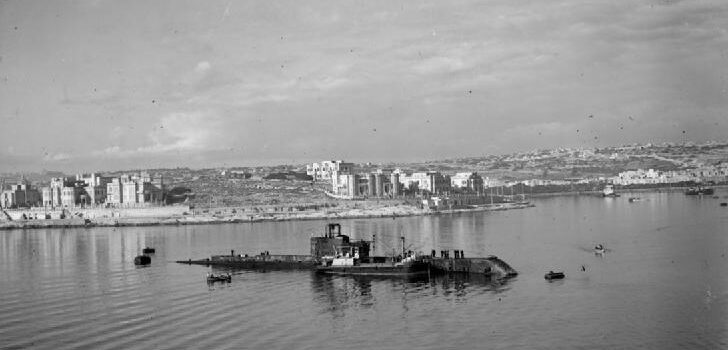
Built at William Beardmore and commissioned on 14 June 1930, HMS Olympus made her initial training in home waters like her sister and join her fast east station in Hong Kong. From 1931 to 1939 she served with the 4th Flotilla, the "China Station". With the war developing she was moved to the Indian Ocean, with the 8th Flotilla in Colombo and in early 1940 redeployed to the Mediterranean. During one of her first wartime sorties on 7 July 1940 she was attacked while docked in Malta by Italian aircraft. She took some damage but aparently no direct hit, so that her repairs and completion of her refit ended by 29 November 1940. She made several sorties throughout the end of the year and most of 1941. On 9 November she spotted and attacked the Italian merchant ship Mauro Croce (1,049 GRT). As torpedoes missed, she surfaced and tried to finish her off gunfire in the Gulf of Genoa but the cargo escaped. Other patrols followed, rather uneventful.
On 8 May 1942, Olympus met her fate, hitting a mine off Malta while just leaving on her way to Gibraltar. The saddest part is that she carried personnel personal from the sunken submersibles Pandora, P36 and P39 destroyed after an air raids (part of the "blitz" in Malta). Still, there were 9 survivors out of 98 aboard which swam 7 miles (11 km) back to Malta.
A team of British and Maltese divers claimed discovery of the wreck in 2008 and later confirmed in 2012, after being explored by a ROV under 115m of water and largely intact apart the mine blast hole.
 Orpheus
Orpheus
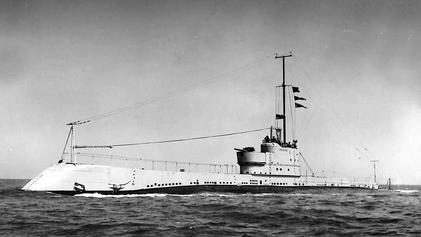
Also built at Beardmore, HMS Orpheus was commissioned on 23 September 1930. After her initial training in home waters she departed for the far east and stayed with the China Station from 1931 to 1939. As the war started she was ordered to Ceylon and from there in 1940, to Aleandria. Her service like Odin was short. During one of her first sorties, she was spotted, gunned, and depht-charged by the Italian destroyer Turbine north of Tobruk, on 27 June 1940. Her wreck was never located but the identification by the Italian crew made possible to make the connection with her disappearance.
 Osiris
Osiris

Commissioned on 25 Jan 1929, and built at Vickers-Armstrongs (Barrow-in-Furness). She was first commissioned for service with the 4th Submarine Flotilla, China Station. By September 1939, she was moved back to the East Indies Station, 8th Flotilla, based in Singapore and later Colombo. By January 1940 she was transferred to the British Mediterranean Fleet at Alexandria, 1st Submarine Flotilla intended to patrol in case Italy joined war.
-16 August 1940: She spotted and sank the Italian merchantman Morea (1,968 tons) 50 nm west of Durazzo in Albania and apparently did it with gunfire after the merchant vessel escaped twice her torpedoes. Despite her small deck gun, she managed to put her on fire, and pierce her unprotected belt, until her demise.
-22 September 1940: Deployed against an Italian convoy in the Otranto Strait, HMS Osiris torpedoed and sank the
Italian torpedo boat Palestro (a former WW1 vintage 875 tons destroyer), 40 nm west of Durazzo in Albania. While back returning to Alexandria she was offered a Jolly Roger, duly hoisted, a well known tradition for British submariners after at least one kill in patrol. One was offered for each.
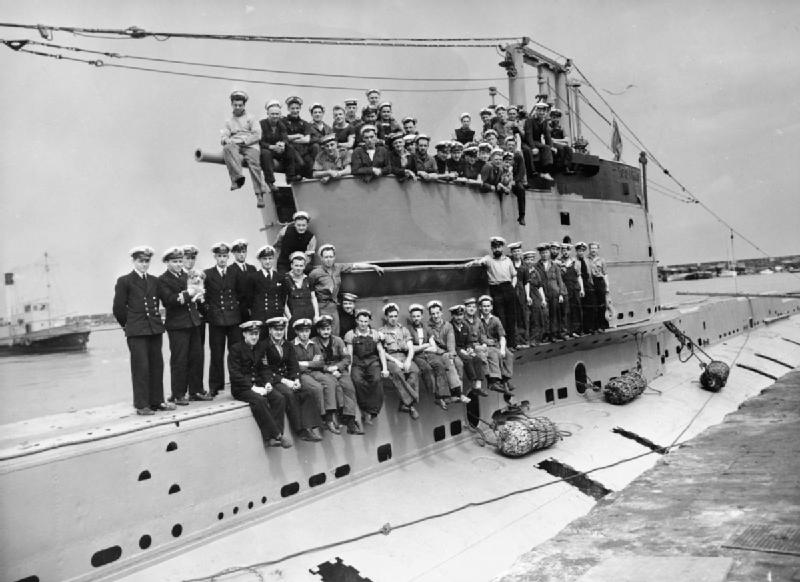 Her proud crew, after receiving two jolley rogers. She was one of the most sucessful O-class submarines and one of the rare to survive WW2.
-14 July 1941:
Her proud crew, after receiving two jolley rogers. She was one of the most sucessful O-class submarines and one of the rare to survive WW2.
-14 July 1941: Osiris spots, closed in an damage the Italian merchant ship Capo d'Orso (3,149 tons) with gunfire. This surface engagement happened near Argostolion (Kefalonia) in Greece. The vessel was badly damaged but had enough buoyancy to escape.
-27 June 1943: Osiris sank the Italian sailing vessel Vittorina (11 tons) north of Crete, also with gunfire.
She would later took part in the
Allied invasion of Sicily in July-August 1943. Her role was to intercept Italian warships on their way to the landing areas.
From August 1943 she returned to the Eastern Fleet, not for activbe patrols but rather training anti-submarine escorts and from November 1944, joined the new East Indies Fleet based in Ceylon.
She was decommissioned on 7 March 1945, sold by September to a company in Durban, South Africa. She was one of the rare subs of this generation to survive the war and one with a shining record.
 Oswald
Oswald
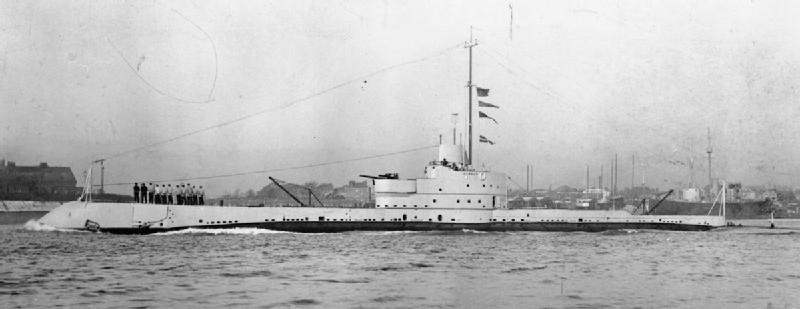
HMS Oswald was laid down by Vickers-Armstrongs at Barrow-in-Furness on 30 May 1927, launched on 19 June 1928 and commissioned on 1 May 1929 and presumably went on the same peacetime routine on the far east as her sisters in the China station. However she was back home in 1939. She was sent to the Mediterranean, Malta via Gribraltar in August 1940.
HMS Oswald commanded by Lt.Cdr. David Alexander Fraser, RN, which succeeded to Lt.Cdr. Geoffrey Mainwaring Sladen, RN in February 1940, made a few wartime sorties before meeting her fate in the summer of 1940.
She left Malta for a patrol east of Sicily on 19 July 1940. On 30 July, she spotted a convoy of several merchant ships and attacked by night the convoy but missed. Soon after she escaped and sent a contact report about this convoy transiting the Straits of Messina. She sailed to the Ionian Sea but now the Regia Marina was in high alert looking for her.
On 1 August 1940 she was spotted while surfaced underway 12 nautical miles south of Capo Spartivento (Calabria). Due to the low vibility she was caught just 2,500 meters away by Italian lookouts aboard the Destroyer Division leader. The hunter killer division comprised the Ugolino Vivaldi, Nicoloso da Recco, Antonio da Noli and Antoniotto Usodimare, modern and well equipped destroyers. She stood little chance. It's Antonia Vivaldi, the closest, which literraly fell on her with gunfire. At 23:05 hours after she was devastated she was apparently finished off by ramming, sinking on 1 August south of Calabria, Cap Spartivento, she went down however slowly enough for 52 crewmen to rescued, 3 lost.
Full records
 Otus
Otus
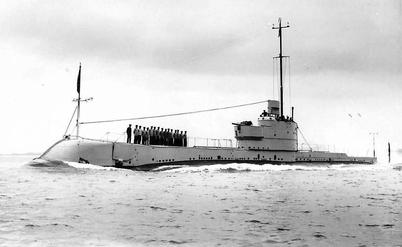
HMS Otus was built at Vickers-Armstrongs (Barrow-in-Furness), commissioned on 5 July 1929.
Otus was first commissioned with the 4th Submarine Flotilla, China Station, until 1939. In Sep^tember she was reported between Singapore and Penang. She had a refit.
From there she was deployed with the 1st Submarine Flotilla, Alexandria, probably with a stop at Cingapore and Ceylon. Her service with the Mediterranean Fleet was longer than some of her sisters. After many sorties in 1940 without notable incident or kill, from July to December 1941 she was based at Malta, intercepting axis convoys as part of the 1st Flotilla. Malta however soon fell under the axis air "blitz" damaging one of her sisters and sinking three other submarines of the P class. She had more luck, not being at home when the attacks went on.
She was later moved to Gibraltar. She carried out patrols off the Azores taking part of the souther flank of the Atlantic defence against U-Boats. She escorted or screened HG convoys passing to and from Gibraltar, soldiering with HMS Olympus. The two also patroled off Oran, in the ope of spotting and attacking Vichy
Battleship Dunkerque reported trying to force her way to Toulon (Operation Principal). But they never spotted her.
On 14 August 1941, she was caught in a friendly fire incident. She was taken for a prey by HMS Talisman (Lt.Cdr. M. Willmott) but escaped the several torpedoes fired at her. It happened circa 140 nautical miles (260 km; 160 mi) north-west of Alexandria.
On 3 September 1941 under command of Lt. R.M. Favell, she sppotted an enemy armed merchant cruiser of 4,000 tons fired but missed. The ship was never identified. It happed 175 nautical miles east of Valletta harbor (Malta). Nothing to report in 1942 but a refit.
In 1943 she was transferred to Simonstown in South Africa like another of her sister, for anti-submarine training due to her age. Large patrol subs of the 1920s were advantageously replaced by the newly built T-class.
By December 1944 was soon to be withdrawn, was paid-off, placed into Reserve and eventually scuttled off Durban in September 1946. Her wreck was rediscovered in March 2013 approximately 8 kilometres (4.3 nmi) south-east of Harbour entrance under 100 m (330 ft).
General assessment
The Odin class (not Oberon or the Oxleys) spent their peacetime career as intended in Asia, with the China Station, before being moved as the war started in the Indian Ocean, between Singapore, Penang and eventually Ceylon. When transferred in the Mediterranean and starting their war patrols, they were more than once caught by Italian escorts. And revealed soon a deadly issue. Indeed all their fuel was carried in external tanks, which were riveted. They were tested to 20 lb/in2 pressure. But in practice, wether due to the Mediterranean waters conditionds of larger depht charges than anticipated, they leaked so much after a single grenade pass, that the unfortunate submarine, whatever her depht, was betrayed by the panache of heavy fuel oil going straight to the surface. By knowing the underwater speed of a British submarine of that class, Italian captains knew full well where to find their prey.
And this was not all. The "O" class had deplorable construction defects alongside the riverting such as defective plating, weak manhole covers and bad equalising arrangements. They all contributing to these issues. The Odin class were drydocked several times while attempting to cure these defects, but to no avail. It shoud be reminded though, that welding ship construction in the 1920s was in its infancy. There were still considerable problems in this new technique and a lack of trust. The British industry in fact relied to riveting for many more years, also for tanks, practically up to WW2. Welded construction eventually was imposed for the next classes. But in all, on the 19 Overseas Patrol Submarines from the O, P and R classes, 12 were lost on active service, HMS Otus being the last survivor in April 1946.
The Odin class paid dearly for her youth problems, although HMS Osiris was by far the most successful of the pack. The last two survivors were sent in South Africa to spend the rest of the war in training, knowing that the infintely superior "T class" were now entering service frontline in droves and were based on the same specifications. In fact the "A" class were supposed to be their replacement for the far east, but they came very late in the war and most were completed in 1946-47.
Read More
Books
Bastock, Australia's Ships of War
"HMAS Oxley (I)". HMA Ship Histories. Sea Power Centre – Royal Australian Navy.
"NMM, vessel ID 327625" (PDF). Warship Histories, vol iii. National Maritime Museum.
Rohwer, p.1 Dundee International Submarine Memorial
Bastock, John (1975). Australia's Ships of War. Cremorne, NSW: Angus and Robertson.
Rohwer, Jürgen (2005). Chronology of the War at Sea 1939–1945: The Naval History of World War Two (Revised & Expanded ed.). NIP
Links
https://www.navy.gov.au/hmas-oxley-i
https://en.wikipedia.org/wiki/Odin-class_submarine
https://en.wikipedia.org/wiki/HMS_Otway
https://en.wikipedia.org/wiki/HMS_Oxley
https://web.archive.org/web/20100502075920/http://www.csubmarine.org/html/boats/odin.html
https://www.battleships-cruisers.co.uk/odin_class.htm
http://rnsubs.co.uk/boats/subs/odin-class.html
http://www.naval-history.net/xGM-Chrono-12SS-01O-Otus.htm
https://uboat.net/allies/warships/ship/3399.html
Model Kits
On www.scalemates.com
1999.co.jp/
On britmodeller.com/ pit-road 1:350
On sdmodelmakers.com
 Oceanic Submersibles 1924-1945:
Oceanic Submersibles 1924-1945:  HMS Oberon was the Odin-class prototype, more than the Oxley class, a derivative planned for the Royal Austrlian Navy. Originally called "O1" she received a full name, HMS Oberon, after a Shakespearian nickname meaning "noble, bearlike" (the very first to be so named, and 5th RN vessel of that name). Commissioned as part of the 1923 naval programme, she was built after the Anglo-Japanese Alliance expired in 1922, with the admiralty willing to create a fleet of far east oceanic submarines able to of long-range patrols there, and possibly deter Japanese ambitions.
HMS Oberon was the Odin-class prototype, more than the Oxley class, a derivative planned for the Royal Austrlian Navy. Originally called "O1" she received a full name, HMS Oberon, after a Shakespearian nickname meaning "noble, bearlike" (the very first to be so named, and 5th RN vessel of that name). Commissioned as part of the 1923 naval programme, she was built after the Anglo-Japanese Alliance expired in 1922, with the admiralty willing to create a fleet of far east oceanic submarines able to of long-range patrols there, and possibly deter Japanese ambitions.
 HMS Oberon in action
HMS Oberon in action HMS Oberon was completed Chatham Dockyard (Kent) and commissioned on August 24, 1927. Her initial pennant was 21.P, changed to 21.N in 1939, and N.21 in 1940.
Her initial sea trials revealed torsional vibrations in her propulsion machinery. Thus, she was never deployed to the Far East du to the lack of repair facilities there. Instead she was stationed in Portsmouth from 1927 and 1931. She was moved from there to the Mediterranean and back to Portsmouth in 1934. On October 11, 1935, she collided with the destroyer HMS Thanet at Devonport. Placed in reserve in 1937, she returned to fully active service by August 2, 1939. She was not deployed for active missions due to her age and instead, was used for training. She was decommissioned at Blyth on 5 July 1944, sold for scrap on 24 August 1945 and BU by Clayton and Davie (Duntson).
HMS Oberon was completed Chatham Dockyard (Kent) and commissioned on August 24, 1927. Her initial pennant was 21.P, changed to 21.N in 1939, and N.21 in 1940.
Her initial sea trials revealed torsional vibrations in her propulsion machinery. Thus, she was never deployed to the Far East du to the lack of repair facilities there. Instead she was stationed in Portsmouth from 1927 and 1931. She was moved from there to the Mediterranean and back to Portsmouth in 1934. On October 11, 1935, she collided with the destroyer HMS Thanet at Devonport. Placed in reserve in 1937, she returned to fully active service by August 2, 1939. She was not deployed for active missions due to her age and instead, was used for training. She was decommissioned at Blyth on 5 July 1944, sold for scrap on 24 August 1945 and BU by Clayton and Davie (Duntson).
 L23 for comparison (1921)
L23 for comparison (1921)
 HMS Odin
HMS Odin
 HMS Oberon
HMS Oberon
 The Oxleys were Odin-class submarines built to a slightly modified design, for Australian service. Indeed, the oceanian continent had a small but potent surface fleet, but lacked submersibles as a deterrence; which became more a concern after the anglo-japanese alliance treaty was ceased. For the same reasons the construction of HMS Oberon and the Odin class was ordered in the first place, to counter a possible expansion of Japan in the far east, the Royal Navy wanted a group of long-range submeribles able to deter the IJN from encroaching on its colonial waters and interests in the region. Australia not only had the manpower, but also the resource and will to integrate submersibles in its fledging navy, and an agreement was struck. After HMS Oberon, the next two submersibles laid down over a slightly revised design would be completed for Australia.
The Oxleys were Odin-class submarines built to a slightly modified design, for Australian service. Indeed, the oceanian continent had a small but potent surface fleet, but lacked submersibles as a deterrence; which became more a concern after the anglo-japanese alliance treaty was ceased. For the same reasons the construction of HMS Oberon and the Odin class was ordered in the first place, to counter a possible expansion of Japan in the far east, the Royal Navy wanted a group of long-range submeribles able to deter the IJN from encroaching on its colonial waters and interests in the region. Australia not only had the manpower, but also the resource and will to integrate submersibles in its fledging navy, and an agreement was struck. After HMS Oberon, the next two submersibles laid down over a slightly revised design would be completed for Australia.
 HMS Oxley in service
HMS Oxley in service After commission, HMS Oxley and Otway were assigned to the 5th Submarine Flotilla but on 8 February 1928, they were sent to Australia, making the longest unescorted voyage for any British submarine. They had to stop in Malta for patching up cracks in both subs engine columns. New improved columns were fabricated and installed and they departed in November, reaching Sydney on 14 February 1929. However with Great Depression, both were placed into reserve in 1930, but made a few exercizes until April 1931 and eventually both were transferred to the RN, economic reaons compounded by London Naval Treaty tonnage limits for Austrlia. Recommissioned on 10 April 1931 they started their second career.
On 29 April, they departed for Malta and once in the Med, multiplied exercizes. In 1939, they were back home in Portsmouth, 5th Submarine Flotilla, then 2nd Submarine Flotilla and August deployed at Dundee and Blyth. Oxley patrolled off the coast of Norway but on 10 September 1939, she was mistook for a U-Boat and sunk by HMS Triton. First submarine loss and first "blue on blue" incident of that nature. It happened when the five submarines of the Second Flotilla (including Triton and Oxley) patrolled on the "Obrestad line" off Norway.
After commission, HMS Oxley and Otway were assigned to the 5th Submarine Flotilla but on 8 February 1928, they were sent to Australia, making the longest unescorted voyage for any British submarine. They had to stop in Malta for patching up cracks in both subs engine columns. New improved columns were fabricated and installed and they departed in November, reaching Sydney on 14 February 1929. However with Great Depression, both were placed into reserve in 1930, but made a few exercizes until April 1931 and eventually both were transferred to the RN, economic reaons compounded by London Naval Treaty tonnage limits for Austrlia. Recommissioned on 10 April 1931 they started their second career.
On 29 April, they departed for Malta and once in the Med, multiplied exercizes. In 1939, they were back home in Portsmouth, 5th Submarine Flotilla, then 2nd Submarine Flotilla and August deployed at Dundee and Blyth. Oxley patrolled off the coast of Norway but on 10 September 1939, she was mistook for a U-Boat and sunk by HMS Triton. First submarine loss and first "blue on blue" incident of that nature. It happened when the five submarines of the Second Flotilla (including Triton and Oxley) patrolled on the "Obrestad line" off Norway.
 A Board of Enquiry after that event found that Cdr. Steel had done "all he reasonably could" in the circumstances in that HLS Oxley was out of position, although to maintain morale, the loss was attributed to "an accidental explosion", the info made public only in the 1950s.
A Board of Enquiry after that event found that Cdr. Steel had done "all he reasonably could" in the circumstances in that HLS Oxley was out of position, although to maintain morale, the loss was attributed to "an accidental explosion", the info made public only in the 1950s.
 HMS Otway in Service
HMS Otway in Service Otway was laid down in March 1925 as "OA2", launched on 7 September 1926, commissioned into the RAN on 15 June 1927. She had the same fate as her sister, seeing little service in Austrlia before sent back to the RN between tonnage and budgetary reasons. When back home she was given the pennant number 51. She served in the same unit as her sister, the 5th sub flotilla patrolling in 1939 off Norway. In 1942 she fell under command of Captain Howard Bone, seeing service in the same service and eventually becoming a training sub in 1945. She was discarded and by August 1945, sold to Thos. W. Ward, Inverkeithing in Scotland for dismantling.
Otway was laid down in March 1925 as "OA2", launched on 7 September 1926, commissioned into the RAN on 15 June 1927. She had the same fate as her sister, seeing little service in Austrlia before sent back to the RN between tonnage and budgetary reasons. When back home she was given the pennant number 51. She served in the same unit as her sister, the 5th sub flotilla patrolling in 1939 off Norway. In 1942 she fell under command of Captain Howard Bone, seeing service in the same service and eventually becoming a training sub in 1945. She was discarded and by August 1945, sold to Thos. W. Ward, Inverkeithing in Scotland for dismantling.
 HMS Odin off Hong Kong in 1931
HMS Odin (N84) was built in Chatham, Kent, on 23 June 1927, launched on 5 May 1928 and commissioned on 21 December 1929. The name was originated on a Danish 74-gun, man-of-war captured by the British in 1807 and used again on an early Cold war british submersible design (Oberon class).
HMS Odin served with the 5th Flotilla in Portsmouth in 1929–1930 for her initial training. Next she was sent to her intended posting, travelling through the Mediterranean and Indian Ocean and up to the join the 4th Flotilla based in Hong Kong, where she served from 1930–1939, but apparently also in Singapore with the 8th flotilla.
With the war coming, she was transferred to the 8th Flotilla moved from Singapore to Colombo, Ceylon by October 1939. In mid November 1939 as the Pocket Battleship
HMS Odin off Hong Kong in 1931
HMS Odin (N84) was built in Chatham, Kent, on 23 June 1927, launched on 5 May 1928 and commissioned on 21 December 1929. The name was originated on a Danish 74-gun, man-of-war captured by the British in 1807 and used again on an early Cold war british submersible design (Oberon class).
HMS Odin served with the 5th Flotilla in Portsmouth in 1929–1930 for her initial training. Next she was sent to her intended posting, travelling through the Mediterranean and Indian Ocean and up to the join the 4th Flotilla based in Hong Kong, where she served from 1930–1939, but apparently also in Singapore with the 8th flotilla.
With the war coming, she was transferred to the 8th Flotilla moved from Singapore to Colombo, Ceylon by October 1939. In mid November 1939 as the Pocket Battleship  Built at William Beardmore and commissioned on 14 June 1930, HMS Olympus made her initial training in home waters like her sister and join her fast east station in Hong Kong. From 1931 to 1939 she served with the 4th Flotilla, the "China Station". With the war developing she was moved to the Indian Ocean, with the 8th Flotilla in Colombo and in early 1940 redeployed to the Mediterranean. During one of her first wartime sorties on 7 July 1940 she was attacked while docked in Malta by Italian aircraft. She took some damage but aparently no direct hit, so that her repairs and completion of her refit ended by 29 November 1940. She made several sorties throughout the end of the year and most of 1941. On 9 November she spotted and attacked the Italian merchant ship Mauro Croce (1,049 GRT). As torpedoes missed, she surfaced and tried to finish her off gunfire in the Gulf of Genoa but the cargo escaped. Other patrols followed, rather uneventful.
On 8 May 1942, Olympus met her fate, hitting a mine off Malta while just leaving on her way to Gibraltar. The saddest part is that she carried personnel personal from the sunken submersibles Pandora, P36 and P39 destroyed after an air raids (part of the "blitz" in Malta). Still, there were 9 survivors out of 98 aboard which swam 7 miles (11 km) back to Malta.
A team of British and Maltese divers claimed discovery of the wreck in 2008 and later confirmed in 2012, after being explored by a ROV under 115m of water and largely intact apart the mine blast hole.
Built at William Beardmore and commissioned on 14 June 1930, HMS Olympus made her initial training in home waters like her sister and join her fast east station in Hong Kong. From 1931 to 1939 she served with the 4th Flotilla, the "China Station". With the war developing she was moved to the Indian Ocean, with the 8th Flotilla in Colombo and in early 1940 redeployed to the Mediterranean. During one of her first wartime sorties on 7 July 1940 she was attacked while docked in Malta by Italian aircraft. She took some damage but aparently no direct hit, so that her repairs and completion of her refit ended by 29 November 1940. She made several sorties throughout the end of the year and most of 1941. On 9 November she spotted and attacked the Italian merchant ship Mauro Croce (1,049 GRT). As torpedoes missed, she surfaced and tried to finish her off gunfire in the Gulf of Genoa but the cargo escaped. Other patrols followed, rather uneventful.
On 8 May 1942, Olympus met her fate, hitting a mine off Malta while just leaving on her way to Gibraltar. The saddest part is that she carried personnel personal from the sunken submersibles Pandora, P36 and P39 destroyed after an air raids (part of the "blitz" in Malta). Still, there were 9 survivors out of 98 aboard which swam 7 miles (11 km) back to Malta.
A team of British and Maltese divers claimed discovery of the wreck in 2008 and later confirmed in 2012, after being explored by a ROV under 115m of water and largely intact apart the mine blast hole.
 Also built at Beardmore, HMS Orpheus was commissioned on 23 September 1930. After her initial training in home waters she departed for the far east and stayed with the China Station from 1931 to 1939. As the war started she was ordered to Ceylon and from there in 1940, to Aleandria. Her service like Odin was short. During one of her first sorties, she was spotted, gunned, and depht-charged by the Italian destroyer Turbine north of Tobruk, on 27 June 1940. Her wreck was never located but the identification by the Italian crew made possible to make the connection with her disappearance.
Also built at Beardmore, HMS Orpheus was commissioned on 23 September 1930. After her initial training in home waters she departed for the far east and stayed with the China Station from 1931 to 1939. As the war started she was ordered to Ceylon and from there in 1940, to Aleandria. Her service like Odin was short. During one of her first sorties, she was spotted, gunned, and depht-charged by the Italian destroyer Turbine north of Tobruk, on 27 June 1940. Her wreck was never located but the identification by the Italian crew made possible to make the connection with her disappearance.
 Commissioned on 25 Jan 1929, and built at Vickers-Armstrongs (Barrow-in-Furness). She was first commissioned for service with the 4th Submarine Flotilla, China Station. By September 1939, she was moved back to the East Indies Station, 8th Flotilla, based in Singapore and later Colombo. By January 1940 she was transferred to the British Mediterranean Fleet at Alexandria, 1st Submarine Flotilla intended to patrol in case Italy joined war.
-16 August 1940: She spotted and sank the Italian merchantman Morea (1,968 tons) 50 nm west of Durazzo in Albania and apparently did it with gunfire after the merchant vessel escaped twice her torpedoes. Despite her small deck gun, she managed to put her on fire, and pierce her unprotected belt, until her demise.
-22 September 1940: Deployed against an Italian convoy in the Otranto Strait, HMS Osiris torpedoed and sank the
Commissioned on 25 Jan 1929, and built at Vickers-Armstrongs (Barrow-in-Furness). She was first commissioned for service with the 4th Submarine Flotilla, China Station. By September 1939, she was moved back to the East Indies Station, 8th Flotilla, based in Singapore and later Colombo. By January 1940 she was transferred to the British Mediterranean Fleet at Alexandria, 1st Submarine Flotilla intended to patrol in case Italy joined war.
-16 August 1940: She spotted and sank the Italian merchantman Morea (1,968 tons) 50 nm west of Durazzo in Albania and apparently did it with gunfire after the merchant vessel escaped twice her torpedoes. Despite her small deck gun, she managed to put her on fire, and pierce her unprotected belt, until her demise.
-22 September 1940: Deployed against an Italian convoy in the Otranto Strait, HMS Osiris torpedoed and sank the  Her proud crew, after receiving two jolley rogers. She was one of the most sucessful O-class submarines and one of the rare to survive WW2.
-14 July 1941: Osiris spots, closed in an damage the Italian merchant ship Capo d'Orso (3,149 tons) with gunfire. This surface engagement happened near Argostolion (Kefalonia) in Greece. The vessel was badly damaged but had enough buoyancy to escape.
-27 June 1943: Osiris sank the Italian sailing vessel Vittorina (11 tons) north of Crete, also with gunfire.
She would later took part in the Allied invasion of Sicily in July-August 1943. Her role was to intercept Italian warships on their way to the landing areas.
From August 1943 she returned to the Eastern Fleet, not for activbe patrols but rather training anti-submarine escorts and from November 1944, joined the new East Indies Fleet based in Ceylon.
She was decommissioned on 7 March 1945, sold by September to a company in Durban, South Africa. She was one of the rare subs of this generation to survive the war and one with a shining record.
Her proud crew, after receiving two jolley rogers. She was one of the most sucessful O-class submarines and one of the rare to survive WW2.
-14 July 1941: Osiris spots, closed in an damage the Italian merchant ship Capo d'Orso (3,149 tons) with gunfire. This surface engagement happened near Argostolion (Kefalonia) in Greece. The vessel was badly damaged but had enough buoyancy to escape.
-27 June 1943: Osiris sank the Italian sailing vessel Vittorina (11 tons) north of Crete, also with gunfire.
She would later took part in the Allied invasion of Sicily in July-August 1943. Her role was to intercept Italian warships on their way to the landing areas.
From August 1943 she returned to the Eastern Fleet, not for activbe patrols but rather training anti-submarine escorts and from November 1944, joined the new East Indies Fleet based in Ceylon.
She was decommissioned on 7 March 1945, sold by September to a company in Durban, South Africa. She was one of the rare subs of this generation to survive the war and one with a shining record.
 HMS Oswald was laid down by Vickers-Armstrongs at Barrow-in-Furness on 30 May 1927, launched on 19 June 1928 and commissioned on 1 May 1929 and presumably went on the same peacetime routine on the far east as her sisters in the China station. However she was back home in 1939. She was sent to the Mediterranean, Malta via Gribraltar in August 1940.
HMS Oswald commanded by Lt.Cdr. David Alexander Fraser, RN, which succeeded to Lt.Cdr. Geoffrey Mainwaring Sladen, RN in February 1940, made a few wartime sorties before meeting her fate in the summer of 1940.
She left Malta for a patrol east of Sicily on 19 July 1940. On 30 July, she spotted a convoy of several merchant ships and attacked by night the convoy but missed. Soon after she escaped and sent a contact report about this convoy transiting the Straits of Messina. She sailed to the Ionian Sea but now the Regia Marina was in high alert looking for her.
On 1 August 1940 she was spotted while surfaced underway 12 nautical miles south of Capo Spartivento (Calabria). Due to the low vibility she was caught just 2,500 meters away by Italian lookouts aboard the Destroyer Division leader. The hunter killer division comprised the Ugolino Vivaldi, Nicoloso da Recco, Antonio da Noli and Antoniotto Usodimare, modern and well equipped destroyers. She stood little chance. It's Antonia Vivaldi, the closest, which literraly fell on her with gunfire. At 23:05 hours after she was devastated she was apparently finished off by ramming, sinking on 1 August south of Calabria, Cap Spartivento, she went down however slowly enough for 52 crewmen to rescued, 3 lost.
HMS Oswald was laid down by Vickers-Armstrongs at Barrow-in-Furness on 30 May 1927, launched on 19 June 1928 and commissioned on 1 May 1929 and presumably went on the same peacetime routine on the far east as her sisters in the China station. However she was back home in 1939. She was sent to the Mediterranean, Malta via Gribraltar in August 1940.
HMS Oswald commanded by Lt.Cdr. David Alexander Fraser, RN, which succeeded to Lt.Cdr. Geoffrey Mainwaring Sladen, RN in February 1940, made a few wartime sorties before meeting her fate in the summer of 1940.
She left Malta for a patrol east of Sicily on 19 July 1940. On 30 July, she spotted a convoy of several merchant ships and attacked by night the convoy but missed. Soon after she escaped and sent a contact report about this convoy transiting the Straits of Messina. She sailed to the Ionian Sea but now the Regia Marina was in high alert looking for her.
On 1 August 1940 she was spotted while surfaced underway 12 nautical miles south of Capo Spartivento (Calabria). Due to the low vibility she was caught just 2,500 meters away by Italian lookouts aboard the Destroyer Division leader. The hunter killer division comprised the Ugolino Vivaldi, Nicoloso da Recco, Antonio da Noli and Antoniotto Usodimare, modern and well equipped destroyers. She stood little chance. It's Antonia Vivaldi, the closest, which literraly fell on her with gunfire. At 23:05 hours after she was devastated she was apparently finished off by ramming, sinking on 1 August south of Calabria, Cap Spartivento, she went down however slowly enough for 52 crewmen to rescued, 3 lost.  HMS Otus was built at Vickers-Armstrongs (Barrow-in-Furness), commissioned on 5 July 1929.
Otus was first commissioned with the 4th Submarine Flotilla, China Station, until 1939. In Sep^tember she was reported between Singapore and Penang. She had a refit.
From there she was deployed with the 1st Submarine Flotilla, Alexandria, probably with a stop at Cingapore and Ceylon. Her service with the Mediterranean Fleet was longer than some of her sisters. After many sorties in 1940 without notable incident or kill, from July to December 1941 she was based at Malta, intercepting axis convoys as part of the 1st Flotilla. Malta however soon fell under the axis air "blitz" damaging one of her sisters and sinking three other submarines of the P class. She had more luck, not being at home when the attacks went on.
She was later moved to Gibraltar. She carried out patrols off the Azores taking part of the souther flank of the Atlantic defence against U-Boats. She escorted or screened HG convoys passing to and from Gibraltar, soldiering with HMS Olympus. The two also patroled off Oran, in the ope of spotting and attacking Vichy
HMS Otus was built at Vickers-Armstrongs (Barrow-in-Furness), commissioned on 5 July 1929.
Otus was first commissioned with the 4th Submarine Flotilla, China Station, until 1939. In Sep^tember she was reported between Singapore and Penang. She had a refit.
From there she was deployed with the 1st Submarine Flotilla, Alexandria, probably with a stop at Cingapore and Ceylon. Her service with the Mediterranean Fleet was longer than some of her sisters. After many sorties in 1940 without notable incident or kill, from July to December 1941 she was based at Malta, intercepting axis convoys as part of the 1st Flotilla. Malta however soon fell under the axis air "blitz" damaging one of her sisters and sinking three other submarines of the P class. She had more luck, not being at home when the attacks went on.
She was later moved to Gibraltar. She carried out patrols off the Azores taking part of the souther flank of the Atlantic defence against U-Boats. She escorted or screened HG convoys passing to and from Gibraltar, soldiering with HMS Olympus. The two also patroled off Oran, in the ope of spotting and attacking Vichy